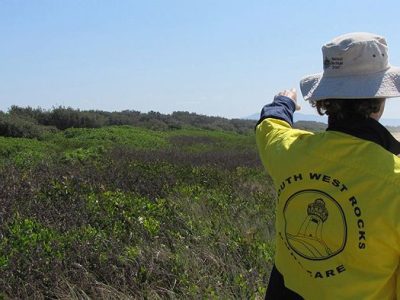Coastal Dune Weeds

Photo source: South West Dune Care
Weeds represent a major impost on our agricultural economy. Up until 1997 in NSW environmental weeds were not rated as significant enough to receive a formal listing. However, some strong lobbying by scientists in the National Parks Service assisted by others managed to get bitou bush designated as a noxious weed. It was quite a break through. Several years later it was included as one of 20 Weeds of National Significance or WONS. I had the pleasure of chairing the group for two years that examined the development and implementation of a strategy to contain and where possible control bitou and its companion species, boneseed. As a member of the committee of weed chairs, it was amazing to meet extremely dedicated men and women, mostly farmers, doing their utmost to reduce the weed menace. This work is ongoing and is a great challenge to the nation’s biodiversity and productivity.
There are many nasty coastal weeds. I am most familiar with bitou. National Parks in NSW has undertaken considerable research and management actions to contain the spread. But so have individual councils and dedicated volunteer groups working under the Dunecare/Coastcare/Landcare umbrellas. In 2008 I presented a paper on the work of such volunteers in honour of the many women who have been active in these movements (the paper can be accessed on the Wentworth Group web site).
Communities and agencies have recognised that bitou severely damages coastal dune ecosystems even spreading into the native vegetation of cliffs and headlands. Bitou was introduced from South Africa early in the 20th century and was promoted at one stage by the NSW Soil Conservation Service as a sand binding plant following mining for heavy minerals. I have met men who were paid by the seedling to plant this invasive. At one stage up to 80% of the NSW coast spreading into southern Queensland was infested by bitou. It remains a problem, ironically on Commonwealth lands near Jervis Bay where I have encountered a bitou “forest”. Attempts at biological control have met with mixed success.
So the battle continues.
How can we achieve improved biodiversity in dune ecosystems?
And will the presence of more native species meet the interests of coastal communities?
This is a difficult question from several perspectives. First, there is the on-going need for research and investment in weed containment and control. Funding for such endeavours through Local Land Services and other agencies, including local councils, may be less forthcoming than in the past. Second, there is the difficulty of community groups maintaining their commitment and recruiting new and younger members to dune management. Third, there often arises conflict between the interests of those who see the need to restore native plants and local residents and beach users who find dune vegetation growth to their personal disadvantage. Surfers, home owners and those who fear bushy plants have lobbied councils to remove not just bitou but also native shrubs.
The question is what is a weed. I once worked with Nigel Wace, a biogeographer at ANU. He enjoyed asking anyone he met, on planes, in the street, on campus, wherever, what is a weed? It went further, he stopped men and asked if they could turn down the cuff of their trousers to see what they were “carrying” as seeds (biased sample, no women!). He then planted the seeds under experimental conditions. What was interesting was the diversity of plants foreign to an area and the diversity of views on what is a weed.
I was remindedof this recently when I read Michael Pascoe’s article in the Sydney Morning Herald (7 March) on what he termed a feral pest, the Norfolk Island pine. He blamed Manly for its introduction. In 1902 it was the officially recommended timber tree for NSW coastal areas, and it extends now into many states. Is it a pest/weed? I sometimes feel we could have done without its introduction, but I am sure many would see the Norfolk Island pine as enhancing the beauty of our foreshores.
– Words by Prof Bruce Thom


